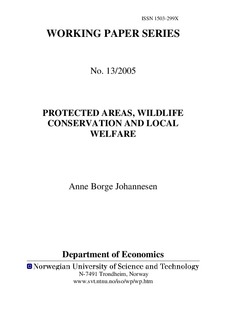| dc.contributor.author | Johannesen, Anne B. | nb_NO |
| dc.date.accessioned | 2014-12-19T14:31:46Z | |
| dc.date.available | 2014-12-19T14:31:46Z | |
| dc.date.created | 2006-10-02 | nb_NO |
| dc.date.issued | 2005 | nb_NO |
| dc.identifier | 126051 | nb_NO |
| dc.identifier.uri | http://hdl.handle.net/11250/267087 | |
| dc.description.abstract | The establishment and expansion of protected areas in Africa have been motivated by the aspiration of increased wildlife abundance. During the past decades, however, this practise has been subject to a massive debate. While some claim that protected areas have failed in preserving African wildlife, others claim that existing protected areas are successful. This paper adds to this debate by presenting a bio-economic analysis of protected area expansion. The model considers a hunter-agrarian community located on the border of a protected area. An expansion of the protected area means less land for agricultural cultivation and hunting. Depending on the economic conditions in these activities, it is demonstrated that protected area expansion may reduce the degree of wildlife conservation. In addition, it may reduce the welfare of the local people. | nb_NO |
| dc.language | eng | nb_NO |
| dc.publisher | Institutt for samfunnsøkonomi | nb_NO |
| dc.relation.ispartofseries | Working Paper Series, 1503-299X; 2005:13 | nb_NO |
| dc.title | Protected areas, wildlife conservation and local welfare | nb_NO |
| dc.type | Research report | nb_NO |
| dc.contributor.department | Norges teknisk-naturvitenskapelige universitet, Fakultet for samfunnsvitenskap og teknologiledelse, Institutt for samfunnsøkonomi | nb_NO |
